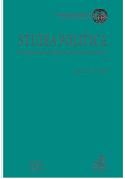Transnistria, the ”General Plan East”, and the ”Shoah by Bullets”.
Transnistria, the ”General Plan East”, and the ”Shoah by Bullets”.
Author(s): Mihai ChioveanuSubject(s): Politics / Political Sciences
Published by: Editura Universităţii din Bucureşti
Keywords: deportations; ethnic-cleansing; anti-Semitism; war; genocide
Summary/Abstract: With the early ”flush of victory” against USSR, and the (under)cover provided by Hitler’s ”war of annihilation” in the East, Ion Antonescu and his regime turned ethnic cleansing into a top priority policy. Mesmerized by the promise of a Jew free Romania, with other ethnic and religious minorities targeted as well, the government easily accepted mass killing, ghettoization, and brutal deportations as means to achieve envisioned ultra-nationalistic ends. However, with late 1942 and the ”pallor of defeat”, at a time the Nazi continent wide Holocaust was in full swing, Bucharest decided to reject the International Final Solution proposed by Berlin. Plans to deport the Romanian Jews to Poland were unexpectedly abandoned, and further evacuations to Transnistria halted. The shift came too late, at a time the evil was already done, and Romania stood on the verge of genocide. Transnistria was by now an infamous ”kingdom of death”. Bullets, famine, hard labor and diseases were effective means in the Romanian process of destruction of the Jews, a process that did not included gas vans and chambers, but in which not one community east of the river Prut was spared. Acting as liaison to the Nazi perpetrators the Romanian ones moved hastily from savage massacres to more bureaucratic ways of killings. The cruelty is striking, and the process is no less structured in its brutality when compared to the Nazi one in the occupied Soviet territories. The importance of Transnistria stays with the staggering number of victims, the expediency of killing operations in the vicinity of villages and towns, very personal, a human butchery that resembles in its mixture of police, military, and bureaucratic violence, efficient and organized, many other killing fields and cases of ethnic cleansing and genocide, and the proximity of the Holocaust in Ukraine, different from the classic Shoah only in terms of framework and method. Moving from here and aiming for clarity, I will try to understand the policy that made Transnistria possible, a development that is not incidental and accidental. Attention is given not only to the Romanian government, institutions and agencies but also to the Nazi perspective on Eastern territories, the empire-building policy in the Ukraine, and the dynamic of the Nazi solution to the Jewish Question. When analyzing the actions and attitudes of the above-mentioned actors in a wider context, my intention is simply to shed some light on the inception and role of Transnistria during the Holocaust.
Journal: Studia Politica. Romanian Political Science Review
- Issue Year: 10/2010
- Issue No: 3
- Page Range: 427-446
- Page Count: 20
- Language: English

